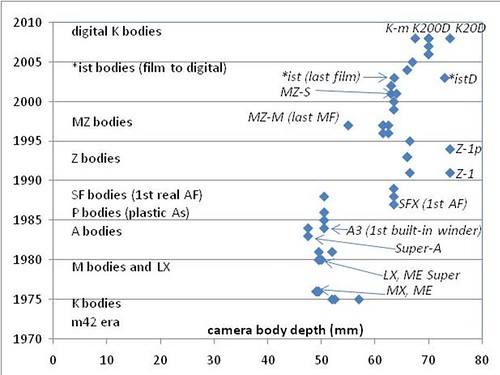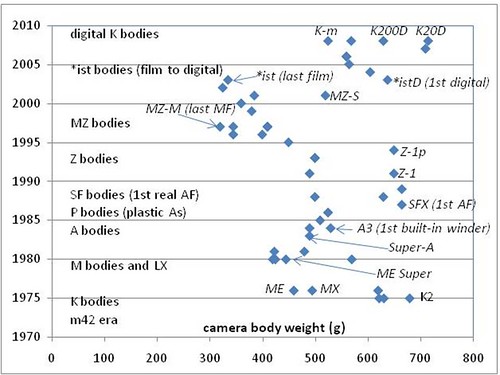 What's this?
What's this?Well, it is a summary of the development since the first Pentax K-mount camera to the current digital SLR K-mount bodies from Pentax. My purpose is to show how the size of the camera bodies have changed with the technical development. In many ways the depth is the most important factor for where you can fit a camera (in which pocket). If you follow the time line you will see how the initial bulky analog K series bodies (that was basically Spotmatic cameras with a K-mount instead of the m42 thread) are replaced by the minimized M serie and A serie models. Then the size begins to increase with the introduction of built-in winder and auto focus. Pentax tried to turn the trend with the MZ series which mimic the old attempts to minimize the size of the M serie bodies, with the MZ-M being the last really small body (and the last with manual focus). Then came the digital era and since the electronics of the picture sensors are thicker than film, the size increased again, though Pentax has successfully tried to make the *istD serie bodies and the K-m among the smallest digital SLRs on the market. But despite this, the bodies have on average got much more bulky (~50%) than they were 30 years ago. So they don't fit in my coat pocket :(
Worth notice is that the respectively top models, (semi)professional or advanced amateur, of most body families: K2, Z-1 and Z-1p, *istD, K20D are larger than the rest of their families. The exceptions are the LX and MZ-S.

Next diagram shows camera body weight instead of body depth. If you follow the time line you will see how the initial heavy analog K series bodies were replaced with the M serie models. Then the size begun to increase with the introduction of more electronics and built-in winder and auto focus. Pentax turned the trend with the MZ series where minimized size and plastic materials replacing metal resulted in the lightest 35mm Pentax SLR bodies ever. Then came the digital era. While it is clear to me that the bodies must get thicker because the electronics of the picture sensors are thicker than film, I don't really understand why the digital bodies have to get heavier. But they did, despite all plastic. Must be all electronics and the fact that the Pentax DSLRs appear better built than the 90's SLR bodies, despite similar amount of plastics. The weight increased despite that Pentax have tried to keep the *istD serie bodies and the K-m compact. Despite all plastics that have replaced all the metal in the K, M and A bodies, we are back were we started: the K20D is about the same weight as the K2 was (top model of the K serie), and the K-m is only slightly lighter than the KM was 30 years ago.
I have not put trends for length and hight into graphs, but they are partly linked to the same factors as seen in these two figures, with some additional effects. The length takes a jump from 130-140mm to 150-160mm with the introduction of the built in winders, which Pentax manage to compensate for in the MZ familly. With the introduction of digital SLRs, the size of the smaller bodies scrink to 120mm or below because there is no need any longer to make room for a film casset to the left side of the camer (seen from behind), while the bigger models remain around 140mm, probably using the space for all the electronics needed in the upper end bodies. With the exception of the initial K familly and the LX (with the standard seaker, it is interchangeable), all early cameras are less than 90mm in height. Then with the intriduction of the built in flash from the SF serie and beyond, the height takes a jump above 90mm (*ist being the only exception). The current top model K20D and the previous K10D is above 100mm high. Not only does the built in flash add about 10mm, but the flash-prisma combo is often much bulkier in all directions than it used to be, which is very noticeable when I try to squeze even the *istDS into my pocket.
I bet that most camera brands (those of the original players that have survived) will show similar trends if you do the work to collect the data graphically, though some will be bulkier on average than the Pentax cameras. Olympus is likely the other manufacturer that will challenge Pentax in the smallest and lightest bodies. Canikon will be bigger with some exceptions, but follow a similar trend with the introduction of built-in driver, autofocus and digital image sensors instead of film. Worth remembering is that not all DSLRs would fit in the pocket even if the body is small, because the brand in question may not have small enough lenses...
In summary: They got shorter (some at least), but higher and thicker, and in terms of weight we are back were we started despite less metal in the bodies. They don't fit in my pocket any longer, not even the *istDS. Maybe the K-m will? On the other hand, my MX, Super-A and Program-A easily fit in my pocket with any of several of my lenses, and even the LX and KX can be squeezed down with one of the smallest lenses. So I will keep in having the MX or Super-A there with a 28mm or 50mm lens. While waiting for a thin enough Pentax DSLR!
And don't try to tell me to get a Olympis E-400-something. It is not a K-mount.
Data sources: Pentax own web pages and folders, and the marvelous http://www.bdimitrov.de/
I might have mixed up weight with and without batteries in some cases. These data are not always reported in a systematic way. It will not change the over all conclusions.













No comments:
Post a Comment